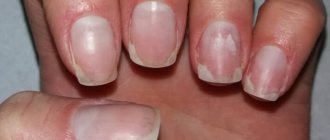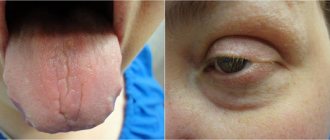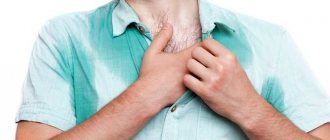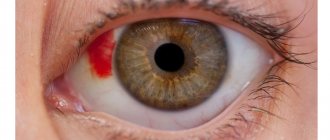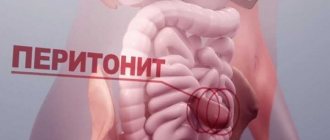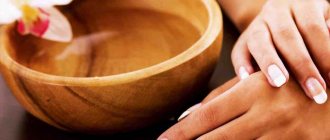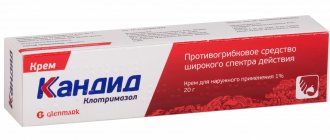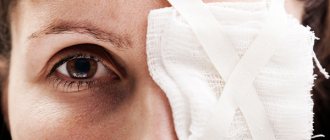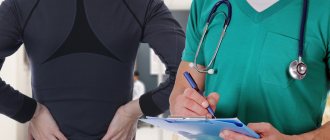What is onychomycosis
Onychomycosis is a disease resulting from fungal infection. It is provoked by the following pathogens:
- Dermatophytes;
- Athlete's foot;
- Microsporia;
- Trichophytosis.
Separately, it is worth highlighting candidiasis, which is provoked by the Candida fungus. The disease is most often diagnosed in females, since the causative agent is a fungus that causes thrush.
Once the fungus gets into the deep layers of the nail, it begins to destroy it at the cellular level in order to be able to feed on the substances that make up it. The pathogen leaves behind waste products. The latter can enter the patient’s lymph and blood, causing harm to the nail plate and the human body.
Onychomycosis of toenails is diagnosed in both children and adults, especially after 65 years. According to ICD-10 (International Classification of Diseases), the disease is classified as parasitic and infectious, disease code - B35.1 (mycosis).
Appearance of onychomycosis on the legs
Causes
The occurrence of onychomycosis of the feet is facilitated by favorable conditions that are created in the area of the nails and surrounding tissues under the influence of factors:
- Not maintaining personal hygiene. You need to regularly wash your feet and change your socks; after water procedures, dry the spaces between your toes well;
- Dry skin. It is necessary to use moisturizing, nourishing and softening foot creams;
- Endocrinopathy. Obesity, diabetes mellitus, hypothyroidism in the patient;
- Immunodeficiencies of various etiologies;
- Dyshidrosis of the feet, in which cracks form in the interdigital area and appear wet.
- Long-term use of cytostatics, antibiotics;
- Problems with blood circulation in the legs - thrombophlebitis, angiopathy, diabetic foot, varicose veins.
- Damage to the nail plate as a result of injury, poor-quality pedicure, uncomfortable shoes, etc.;
- Visiting public swimming pools, hospitals, beach decks, showers in sports centers barefoot and without your own hygiene products.
How does fungal infection occur?
The causative agent of the disease, a population of fungal spores, thrives in moisture.
Therefore, infection most often occurs in the following places:
- public baths;
- saunas;
- swimming pools;
- changing rooms in gyms, showers.
Scales with fungal diseases disappear in patients with onychomycosis, settling mainly on carpets, floors, benches, unpainted wooden objects - there they multiply faster. Nail damage is most often caused by sharing shoes, towels and washcloths. Insufficient cleanliness of premises is often the cause. Inflammation of the nail plates on the hands usually occurs due to the scratching of microorganisms on the skin.
Onychomycosis often affects a person for the second time, even with prior use of antifungal drugs. If the pathogen is not completely destroyed, sooner or later the problem will return. In particular, this applies to treatment methods associated with nail removal - if the operation was performed incorrectly, the disease spreads to neighboring fingers. In addition, there is a possibility of becoming infected with new microorganisms due to unsanitary conditions.
People with repeated nail injuries, such as athletes, are at risk. Patients with diabetes and blood pathologies should also be concerned.
Symptoms and forms of the disease
Fungal infections of toenails come in several types, depending on the clinical picture:
- Normotrophic. The shape of the nail plate does not change as a result of the lesion, but yellowing of the surface and thickening of the corners become noticeable;
- Hypertrophic onychomycosis. Nail deformation is more obvious. The plate loosens and begins to break, turn yellow, and darken. The shape changes;
- Atrophic onychomycosis. The nail breaks, is destroyed from the inside, and gradually moves away from the skin.
Separately, the disease is divided by localization. Each type has its own characteristics:
- Distal view. Symptoms of onychomycosis appear at the free edge of the nail plate. The appendages thicken and darken until they turn brown. This form of fungal infection on the legs is more common than others;
- Lateral. In this case, the sides of the nail become infected. Pathology can gradually reach the matrix and affect deeper layers;
- White superficial onychomycosis. Damage to the upper layers of the plate, gradually spreading to the deep nail bed. The color and structure of the nail changes pathologically, it crumbles and splits.
- Proximal. The disease begins with an inflammatory process in the cushion. The fungus enters the nail plate through the injured cuticle or matrix. In this case, the pathology quickly affects all layers and zones.
- Total – fungal infection of the entire nail.
The disease goes through 3 stages, each of which has its own characteristics. The initial stage of onychomycosis is characterized by a change in the color of the nail plate - the surface darkens and becomes uneven. Then the nail begins to deform, flaking and thickening. At the second stage, not only the nail becomes inflamed, but also the surrounding tissues. At the third and final stage of the disease, the plate crumbles, and in some cases completely falls apart. Photos of onychomycosis of nails are shown below.
Various forms of onychomycosis
Methods for diagnosing pathology
It is difficult to make a correct diagnosis on your own, since the symptoms of onychomycosis are similar to the signs of some other diseases: seborrhea, eczema, psoriasis, etc. Even an experienced doctor does not rely on a visual examination alone. It is necessary to conduct a laboratory analysis, examine the nail scraping, and then make a final diagnosis.
Note.
If there is a suspicion of onychomycosis of the toenails, fluorescent diagnosis is most often used, when the affected nail plate is examined using a Wood's lamp.
How and how to treat onychomycosis of toenails
The treatment regimen depends on the severity of the pathology. The initial stage of onychomycosis can be treated with the help of varnishes, ointments and creams - external preparations. In more advanced cases, surgery may have to be resorted to.
Several of the following methods and types of medications are used simultaneously to treat nail onychomycosis:
- The use of systemic antifungal antimicrobial drugs.
- The use of drugs that improve blood flow in the peripheral tissues of the extremities.
- Application of local formulations to the affected areas - varnishes, ointments, gels, solutions, pastes, etc.
- The procedure for removing the nail using a conservative or surgical method in case of total damage to the plate and/or a high degree of thickening.
- Completing a course of physiotherapy procedures that have a beneficial effect on blood circulation in the patient’s hands and feet.
Treatment of onychomycosis of toenails should be carried out as soon as the diagnosis is made. The infection rapidly develops and spreads, and topical antifungal medications give results only in the initial stages. In more complex cases, the use of systemic drugs is required. It is a comprehensive treatment regimen that will be most effective.
Pathology treatment methods
Effective inexpensive medicines
Patients suffering from nail fungus can take advantage of high-quality medications that are suitable for people of any income. Therapy can take from 9 to 18 months for fungus on the feet, and from 4 to 6 months for fungal infections on the fingers. Effective tablets for onychomycosis are:
- Ketoconazole;
- Itraconazole;
- Fluconazole;
- Griseofulvin.
The course of treatment of nail onychomycosis with inexpensive but effective drugs takes 3-6 months. Then the medicine must be replaced with another with a similar effect, so that the fungal pathogen does not develop resistance to the drug.
Other forms of pharmaceutical compositions are often prescribed:
- Bifosin, Nizoral - creams;
- Lamisil, Thermikon - sprays;
- Lotseryl, Batrafen – varnishes;
- Creolin, Fukortsin - antifungal solutions;
- Mycozoral - ointment;
- Keratolytic and trichloroacetic patches.
To cure the disease, tablets for onychomycosis and topical preparations must be used strictly according to the instructions. So, varnish against fungus Loceryl is applied only to nails that have been previously washed in hot water and dried. You must first clean the nail plate with a disposable nail file, carefully trim it, and only then apply the medicine. The skin located next to the affected nail should be treated with alcohol.
Pills and other forms of medicine to treat illness
Drugs to improve blood circulation
To improve blood flow in the area of the toes and hands with onychomycosis, effective drugs are used that ensure the delivery of drugs to the nail plate in the proper concentration. Increasing the intensity of blood circulation also has a beneficial effect on the rate of regrowth of a healthy nail, which speeds up the treatment time. To do this, it is recommended to use the following medications:
- Calcium dobesilate – 3 times a day, 250-500 mg (Doxium, Doxie-Chem).
- Pentoxifylline – 2-3 times a day, 400 mg (Agapurin, Trental).
- Nicotinic acid – 150-300 mg three times a day, or 15 injections of 1 ml (a 1% solution is taken).
Physiotherapy
Physiotherapy is a modern method of combating onychomycosis. Such procedures are not able to directly affect the pathology, and therefore must be used in combination with other methods of treatment. Physiotherapy can improve blood circulation in the extremities affected by the fungus. For onychomycosis, the following are most often prescribed:
- Diathermy on the lumbosacral area.
- Laser therapy of the nail plate.
- Laser irradiation of blood on peripheral vessels.
- UHF and amplipulse effects on the lumbosacral and cervical regions.
Medicines and physical therapy to improve blood flow
Medications
Many of the home remedies are quite effective only in the initial stages of fungal nail infections. Baths, lotions, and oils complement the main therapy well and speed up the healing process.
Among the effective medications, the best remedies for fungus on the nails of the hands and feet are Nizoral and Exoderil creams, Mycomax capsules for internal use, Clotrimazole gel and liquid.
These drugs help get rid of the disease even with the most serious lesions. They are used until the nails are completely restored and are used strictly as prescribed by the doctor, according to the attached instructions. You should not prescribe your own treatment by purchasing various medications at the pharmacy. The trial and error method wastes valuable time and money. Each drug has an effect on a specific group of fungi. The wrong medicine simply won't work. Therefore, before purchasing medications, you should be tested to determine the type of causative agent of the disease.
Methods for removing the affected nail plate
If conservative treatment of onychomycosis does not work, the nail may need to be removed. This will reduce the duration of therapy. The affected nail plate can be removed using special medications, a laser, or surgery.
Pedicure using pharmaceutical products
Medicines based on keratolytics allow you to remove the nail with mild onychomycosis. Preparations such as Onychoplast, Ureaplast, Salipod or Mycospor are used.
Before using them, you need to steam your feet well. Next, carefully remove the top layer of the nail plate using a disposable nail file, which comes with the kit. Then apply a patch or use a solvent. Cover the skin around the diseased nail with a band-aid or apply zinc ointment to it.
The softened nail must be removed after the time specified in the instructions for the medicine. Remove the plate using a file or a special scraper.
Laser exposure
In cosmetology centers, treatment of onychomycosis is carried out using a laser. The nail is removed after thorough cleaning and application of a disinfectant composition to the surface. The plate is cut down layer by layer, and an antimicrobial drug and a sterile bandage are applied to the nail bed.
Note!
The procedure for laser nail removal for onychomycosis is painless and takes no more than 10-15 minutes.
Surgical method
This is a radical treatment for onychomycosis, when the nail plate is surgically removed. The damaged nail is removed partially or completely, the nail bed is exposed. If the matrix was involved in the process, total or marginal matrixectomy is used. As a result of this procedure, the new nail plate is damaged, leaving a noticeable cosmetic defect. The surgical method is painful and requires lengthy rehabilitation.
Nail removal methods
Antifungal varnish, does it work?
Anti-fungal nail polish has only recently been used, but the benefits of this product have already been appreciated by many. If the mycotic process is detected through diagnostics in the early stages, then varnish can be used as a monotherapy. The active antifungal components contained in it will do their job and destroy spores of microorganisms.
We suggest you read: Corns on the big toe: how to get rid of them
This group of antifungal agents includes:
- Mikozan - serum along with files for removing plates. It treats nail mycosis and nourishes the tissues.
- Batrafen is a varnish used according to the scheme: in the first month, every other day, then 2 times a week, in the third month - once a week. After this, you need to use the varnish weekly until complete recovery.
- Loceryl is a varnish that destroys spores at the cellular level. It is applied twice a week for 5-6 months.
- Oflomil and Cyclopiroxolamine are similar varnishes with a similar pattern of use.
The duration and regimen of procedures must be carried out exactly; the therapeutic effect cannot be interrupted. To hide the unaesthetic shape of the plates, it is recommended to do a manicure with regular varnish after applying the medicinal coating.
What should be the treatment for onychomycosis of nails? The drugs are inexpensive, but effective, you can choose by reading the instructions for use.
Varnish Loceril
Contains 5% active substance. Suitable for prevention and treatment when the first signs of the disease are detected. The polish kit includes tools for nail treatment and polish application.
Lac Loceryl - suitable for prevention and treatment when the first signs of the disease are detected
These include:
- Ketoconazole;
- Terbinafine;
- Fluconazole;
- Griseofulvin;
- Itraconazole
Taking medications, depending on the chosen remedy and the results of treatment, can last from 3 months to six months. If treatment was interrupted or there was a relapse, then when re-treating, a different drug should be used, because the fungus develops resistance and treatment with the same drug will not produce results.
Treatment of nail onychomycosis will be more successful if inexpensive but effective creams, ointments, gels and sprays are used simultaneously with tablets. Such drugs will help you quickly and effectively cope with the disease.
Fluconazole has an antifungal effect
Traditional methods of combating onychomycosis
Treatment of onychomycosis at home can be carried out using folk remedies, when natural plant components are used. Decoctions for compresses, oils, rubbing, and homemade ointments help. The most popular recipes that help your nails heal faster:
- Nettle infusion. Take dry leaves of the plant, chop and pour 2 tablespoons of raw material with 1 glass of boiling water. After an hour, strain the medicine, soak a gauze bandage in it and apply a compress to your leg. It is recommended to leave the bandage on overnight;
- Onion-garlic ointment. Squeeze 1 tablespoon of onion and garlic juice into a container. Add 1 tablespoon of melted butter to the mixture. Cool the mixture to room temperature, then apply the resulting ointment to the affected areas. Feet should be steamed before using home remedies;
- Tea tree oil. Apply one or two drops to the nail plate affected by onychomycosis, rub in, then cover with a band-aid. Using oil will help separate the affected nail and speed up the regeneration process. Cinnamon, clove, oregano and lavender oils have similar antifungal properties.
Shoe processing
The issue of disinfecting shoes during treatment for onychomycosis is very important, because they contain fungal pathogens, which in the future will cause a relapse of the disease. To eliminate them, you need to use chemical disinfectants. This cleansing procedure should be carried out at least once a week. Disinfection can be carried out using the following compounds:
- Formalin solution 25%.
- Chlorhexidine bigluconate solution 1%.
- Acetic acid 40%, etc.
As a preventative measure, you should regularly use special devices designed for drying shoes at home. Fungi develop in damp environments, so you should not leave your shoes wet.
To eliminate the disease, you must strictly follow all doctor's instructions. Medicines must be used exactly as directed. Home remedies can help speed up the treatment process for onychomycosis, but only if used as an adjuvant solution in combination with traditional drug treatment.
Prevention of mycoses
Primary prevention: foot skin care to prevent microtraumas, abrasions, eliminate hyperhidrosis (aluminum chlorohydrate 15% + decylene glycol 1%) or dry skin (tetranyl U 1.5% + urea 10%), flat feet, etc.
Secondary prevention: disinfection of shoes and gloves once a month until complete recovery:
- undecylenamidopropyltrimonium methosulfate, spray
- chlorhexidine digluconate, solution 1%.
IF YOU HAVE ANY QUESTIONS ABOUT THIS DISEASE, CONTACT DOCTOR DERMATOVENEROLOGIST KH.M. ADAEV:
EMAIL:
INSTAGRAM @DERMATOLOG_95
« Previous entry
